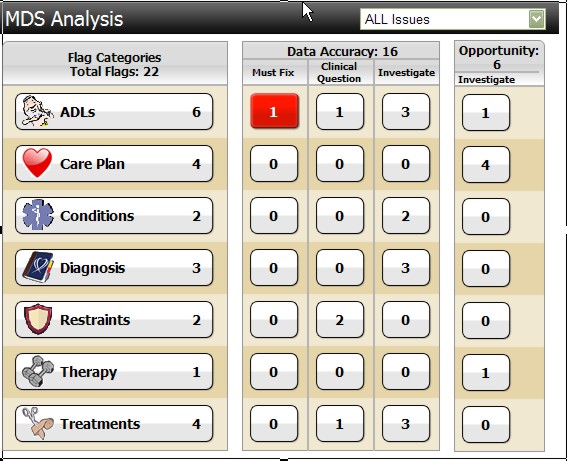The main objective of MDS Intelligence – Daily Clinical Management (DCM) is to provide daily analysis of MDS data whether the MDS is complete or not. DCM will take MDS submission files and parse them into MDS data fields for analysis, or obtain the information directly from the clinical system's MDS tables before MDSs are completed. Rules will run on each MDS and generate flags alerting facilities to potential accuracy issues, revenue opportunities, and care plan opportunities. Facilities can choose which rules to turn on and how each flag is to be resolved.

Flags are divided by Categories, Type, and Severity. Categories include ADLs, Care Plans, Conditions, Diagnosis, Restraints, Therapy, and Treatments. Clicking on any of the available Categories will allow the user to see a detailed view of issues identified within the selected area.
Flags can be based on information within the same MDS for a resident. For example, an MDS would be flagged if it identified a resident is hemiplegic, but is assessed with no limitation for range of motion. Flags can also be raised comparing different MDSs. For example, a resident was an amputee on the last MDS, but not on the current MDS.
The facility will have two ways to resolve the flags. They will be able to alter the MDS, if appropriate, prior to its completion which will remove the flag automatically, or they will be able to manually resolve the flag without any changes to the MDS. Recommendations for how to resolve these rules are customisable by the user. See also: Work with Flags.
Flag Types
Data Accuracy: Accuracy flags indicate the MDS data should be re-checked for data accuracy. For example, if an ADL score for Eating is an ‘8’; it is very possible that the data was entered incorrectly in the MDS.
• Accuracy Issues have three levels of severity: Must Fix, Clinical Question, and Investigate. The user has the ability to change the severity for each rule. Must Fix issues will be highlighted in red indicating a high level of urgency for resolution.
Opportunities: Opportunities indicate an opportunity for improved financial reimbursement or suggestions for care planning. For example, if a resident is close to the number of therapy minutes to jump to the next RUG Rehab category, an opportunity will be flagged.
Alerts: Alert flags may help a user identify opportunities because of the information contained in the MDS. For example, communication flags may suggest that a Care Plan address an item based on the MDS responses.